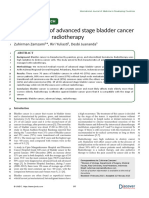Professional Documents
Culture Documents
Radiotherapy of Oligometastatic Prostate Cancer Experience of The Mohamed VI Center For Cancer Treatment in Casablanca, Morocco
Original Title
Copyright
Available Formats
Share this document
Did you find this document useful?
Is this content inappropriate?
Report this DocumentCopyright:
Available Formats
Radiotherapy of Oligometastatic Prostate Cancer Experience of The Mohamed VI Center For Cancer Treatment in Casablanca, Morocco
Copyright:
Available Formats
Volume 8, Issue 4, April – 2023 International Journal of Innovative Science and Research Technology
ISSN No:-2456-2165
Radiotherapy of Oligometastatic Prostate Cancer:
Experience of the Mohamed VI Center for Cancer
Treatment in Casablanca, Morocco
Ismael Coulibaly1, Meryem Zaouit1, Hanane Rida1, Chékrine Tarik1, Mouna Bourhafour1, Zineb Bouchbika1,
Nadia Benchakroun 1, Hassan Jouhadi1, Nezha Tawfiq1, Souha Sahraoui1
1
Mohamed VI Center for the treatment of cancers, CHU Ibn Rochd, hospital districts, 20360 Casablanca, Morocco
Abou Dao2
2
Joseph Ki-Zerbo University, UFR / SDS, Ouagadougou _ Burkina Faso
Corresponding Author :- Ismael Coulibaly1
Abstract :- hypofractionated and those irradiated in conventional
fractionation.
Backgraound
Oligometastatic disease is an intermediate stage Conclusion
between locally advanced disease and multi-metastatic The limit of our study lies in the small size of our
disease. We report the experience of the Mohamed VI sample but also in its retrospective nature. Prostate
Center for the Treatment of Cancers in the management radiation therapy remains a treatment option for de
of oligometastatic prostate cancers in a retrospective novo oligometastatic prostate cancer.
series from 2016 to 2019.
Keywords:- Prostate, Adenocarcinoma, Metastasis,
Method Radiotherapy, Morocco.
We collected cases of de novo metastatic prostate
adenocarcinoma judged to be oligometastatic and having I. INTRODUCTION
benefited from radiotherapy on the prostate. The
primary endpoints were: progression-free survival and Hellman and Weichselbaum pioneered the concept of
overall survival at 2 and 3 years. The proportions were oligometastatic disease in 1995 [1]. It is an intermediate
compared by the CHI 2 test with a significance level of stage between locally advanced disease and multi-metastatic
0.05. The Kaplan Meier model was used to compare disease [2]. This concept of oligometastasis has largely
survivals. evolved with imaging techniques and therapeutic
possibilities. In practice, the qualification of oligometastasis
Result uses various notions such as the metastatic mass, the number
We had recruited 37 patients with a median age of of metastases detectable in imaging, the number of organs
70 years. The initial PSA was between 11 ng/ml and 1635 affected, the number of subunits within an organ which can
ng/ml with an average of 160 ng/ml. The Gleason score be decisive in terms of therapeutic possibilities [3].
was between 8 and 10 in 46 % of patients. A secondary However, the definition of oligometastatic prostate cancer
bone location was present in 100% of cases and no varies in the literature [4]. It depends on the number of
patient had a visceral metastasis. The vertebral seat was metastases, the type of imaging, and the site of the
the most common secondary bone site (55%). The metastases. Most publications set the maximum number of
maximum number of metastatic sites was 3. The median metastases at 5. Conversely, in other clinical trials, a lower
follow-up is 38 months. Overall survival at 24 months number of secondary locations (< 3) was necessary to define
and 36 months, respectively, was 92% and 86%. The 2- oligometastatic cancer [5]. Our study aims to report the
year and 3-year progression-free survival was 84% and experience of the Mohamed VI Center for the Treatment of
79%, respectively. There was no statistically significant Cancers in the management of oligometastatic prostate
difference in either overall survival or progression-free cancers.
survival between patients who received radiation to the
prostate alone and those who received radiation to the II. METHOD
prostate plus the pelvis (p = 0.86). No significant
difference was observed in terms of survival between the We retrospectively collected all patients with de novo
patients who received in addition to local radiotherapy metastatic prostate cancer judged to be oligometastatic on
and primary palliative chemotherapy and those who the basis of CT and scintigraphy and who received
received only local radiotherapy. The low statistical radiotherapy to the prostate in the period from 2016 to 2019.
power of our sample did not allow us to obtain a Patient monitoring was quarterly by the PSA. Biological
significant difference between patients irradiated in progression was defined by the rise of the PSA to more than
IJISRT23APR1476 www.ijisrt.com 1475
Volume 8, Issue 4, April – 2023 International Journal of Innovative Science and Research Technology
ISSN No:-2456-2165
2 ng/dl plus the nadir PSA. We used as a data collection in 38% and 49% of cases. No patient had visceral
source the computerized patient registration system of the metastasis. A secondary bone localization was present in
Mohamed VI center for the treatment of cancers in 100% of cases. A lumbo-aortic lymph node localization was
Casablanca. Data entry and analysis were performed using found in 3 patients in addition to the secondary bone
SPSS software version 21. The proportions were compared localization. The vertebral location was the most frequently
using the CHI 2 test. The ORs adjusted by a logistic encountered secondary bone site. The maximum number of
regression model were also presented with their 95% CIs secondary sites in a patient was 3. There were no more than
with a significance level of 0.05. We used the Kaplan Meier 2 vertebral levels affected in the same patient. On the whole
model to compare survival from the time of diagnosis. of the vertebral column there were no more than 3 vertebrae
affected. Half of the patients had only 2 bone secondary
III. RESULTS localization sites. For treatment, we found that 13 of the 37
patients received docetaxel-type chemotherapy in addition to
We recruited 37 patients with a minimum age of 57 hormone therapy. This chemotherapy was instituted before
years and a maximum age of 88 years with a median age of radiotherapy, it concerned patients who had pain but also
70 years. The majority of patients were brown-skinned, those who had a high PSA level. Chemotherapy was done
76%. Thirty of the 37 patients had no comorbidities. A with docetaxel on 21 days. Among the 13 patients who had
family history of prostate cancer was found in 3 patients. chemotherapy, 3 needed a second line before radiotherapy,
The majority of patients had a good general condition at the including 2 patients with carboplatin and 1 with etoposide +
first consultation, i.e. 19%, 78% and 3% respectively for a cisplatin. The total number of cures was 9 in 1 patient, 8 in 1
WHO performans status (PS) of 0; 1 and 2. The initial PSA patient also, 7 in 04 patients and 6 in 07 patients. Only one
was greater than 20 ng/ml in 84% of cases. None of the patient benefited from a laminectomy. All 37 patients
patients had a PSA lower than 10 ng/ml. The extreme values underwent radiotherapy of the prostate, 28 of which were
of the initial PSA were 11 ng/ml and 1635 ng/ml with an intensity modulated (Table1). Analgesic radiotherapy on the
average of 160 ng/ml. There was already bone symptoms in bone metastasis was performed in 4 patients before local
16% of cases at the time of diagnosis. In terms of extension radiotherapy on the prostate. The majority of patients (76%)
assessment, all the patients had performed the thoraco- were irradiated at the same time on the prostate and the
abdomino-pelvic CT, only one patient had not performed the pelvic lymph nodes in prophylaxis, with 74 Gray in
scintigraphy at the time of diagnosis. Choline PET was conventional fractionation. In addition to local radiotherapy,
performed in only 16% of patients and those following all patients received hormone therapy, with LHRH analog in
progression or relapse. Prostatic adenocarcinoma was the 20 patients and by pulpectomy in 17 patients. Side effects of
only histological type found. Prostate biopsy was the most treatment were observed in 65% of patients. The
common mode of diagnosis at 84%. We noted 46% of complications found are, among others, acute
Gleason score between 8 and 10; 43% had a Gleason score radiodermatitis grade 2, radiation proctitis, hot flushes,
of 7 and only 11% (04 patients) had a Gleason score of 6. gynecomastia, sexual weakness respectively in 11% of
For the poor prognostic factors, we found the presence of cases, 11%, 24.3%, 14%, 49% of cases (Table 3).
vascular embolism and perineural ensheathing respectively
Table 1 Description of Radiotherapy
n %
TYPE OF RADIOTHERAPY
VMAT 28 75.7
3D 9 24.3
RADIOTHERAPY SITES
Primitive alone 33 89.2
Primitive + metastasis 4 10.8
IRRADIATION VOLUME
Prostate + lymph nodes 28 75.7
Prostate alone 9 24.3
DOSE AND FRACTIONATION
60 Gray in 20 fractions 9 24.3
74 Gray 37 fractions 28 75.7
Table 2 Patients Characteristics
n (%)
GLEASON SCORE
Gleason 6 04 (11%)
Gleason 7 16 (43%)
Gleason 8 09 (24%)
Gleason 9 07 (19%)
Gleason 10 01 (03%)
IJISRT23APR1476 www.ijisrt.com 1476
Volume 8, Issue 4, April – 2023 International Journal of Innovative Science and Research Technology
ISSN No:-2456-2165
BONE SITES OF METASTASIS
Vertebrate 28 (55%)
Pelvic 19 (37%)
Femur 01 (02%)
Scapula 03 (06%)
DISTRIBUTION OF VERTEBRAL METASTASIS
Cervical 01 (03%)
Thoracic 16 (50%)
Lumbar 11 (34%)
sacred 04 (13%)
NUMBER OF METASTASIS
1 15 (42%)
2 18 (50%)
3 03 (08%)
For the response to treatment, 81% remission was noted 3 months after the end of radiotherapy with a total PSA of less than
2 ng/ml. Among the 07 patients who were in progression, 02 were in biological progression and 05 in biological and radiological
progression. Deaths at 3 years of follow-up were 08, including 02 patients who died of coronavirus infection (COVID 19) with
PSA levels remaining undetectable. Overall survival at 24 months and 36 months, respectively, was 92% and 86%. The median
follow-up is 38 months with extremes of 10 months and 60 months. Patients alive and in biological and radiological progression
are 22%. In univariate analysis, there is no statistically significant difference in overall survival or progression-free survival
between patients who received irradiation of the prostate alone and those who received irradiation of the prostate plus the pelvis.
The same was true between those who received radiotherapy of the primary alone and those who received radiotherapy of the
primary plus the bone metastasis. No significant difference was observed in terms of survival between the patients who received
in addition to local radiotherapy and primary palliative chemotherapy and those who received only local radiotherapy (figure 1).
Table 3 Treatment Complications
n %
Grade 2 radiodermatitis 04 10.8
Grade 4 aplasia 01 02.7
Radiation cystitis 01 02.7
Radiation proctitis 04 10.8
Gynecomastia 05 13.5
Hot flush 09 24.3
sexual weakness 18 48.6
Urinary incontinence 01 02.7
Fig 1 Overall Survival Curve According to Chemotherapy
IJISRT23APR1476 www.ijisrt.com 1477
Volume 8, Issue 4, April – 2023 International Journal of Innovative Science and Research Technology
ISSN No:-2456-2165
Fig 2 Curve of Overall Survival According to the Volume of Irradiation
IV. DISCUSSION and their axial or peripheral location represent a major
prognostic factor [13]. In our cohort, 38% of patients had a
The definition of oligometastatic disease remains single bone metastasis and the vertebral location was the
heterogeneous to this day. In the literature, the number of 5 most represented at 55%. No visceral metastasis was found.
maximum bone metastases is the number of secondary We did not note any significant difference in terms of
locations accepted to remain in the oligometastatic [6, 7, 8]. survival according to the number of secondary locations due
In our study, the maximum number of metastatic sites was 3. to the low statistical power of our sample. For a long time,
However, it is recognized that the diagnosis of the metastatic cancers from the outset were unequivocally
oligometastasis stage depends on the capacity of the imaging considered to have an unfavorable prognosis and only
used for the extension assessment [9]. Currently, the systemic treatments were considered [15]. Oligometastatic
standard metastatic assessment recommended by learned disease appeared to be a clinical and prognostic entity in
societies for prostate cancer is scintigraphy and computed which the place of local treatment (of the primary lesion
tomography [10]. However, with advances in molecular and/or metastases) would make it possible to lengthen
imaging techniques, more and more metastases are being overall survival or to delay the progression of the disease
detected. This do that, many patients considered as non- [6]. At the biological level, the local irradiation of the
metastatic in conventional imaging could have an primitive in addition to preventing the formation of
oligometastatic disease, just as an oligometastatic disease cytokines and circulating tumor cells, would interrupt the
could turn out to be polymetastatic with the new imaging process of self-censorship and the formation of metastatic
techniques (PET-choline and PET-PSMA). Positron niches. Radiotherapy would also make it possible to
emission tomography using choline (PET-choline) has a eliminate pro-genitor cells at the origin of resistance to
relatively good specificity of 89.5 to 99.7% and a positive systemic treatments [16]. Lymphocyte activation via pro-
prediction unlike bone scintigraphy which has a specificity inflammatory molecules resulting from radiation-induced
and sensitivity around 65%, which implies that part of the cell death could induce an anti-tumor immune response
metastases is not detected in the standard assessment [8, 11]. [17,18]. This immunomodulatory action of radiotherapy
associated with the abscopal effect described since 1953
The most promising radiotracer in metabolic imaging constitutes a source of enthusiasm in the treatment of cancer
is PSMA (Prostate Specific Membrane Antigen) mainly due to improve overall survival or to delay the progression of the
to increased avidity of the absorption at PSA thresholds disease. As regards oligometastatic prostate cancer, prostatic
below 5 ng/dl [11]. In 15 patients with localized prostate irradiation could limit the capacity of the primary tumor to
cancer considered high risk on scintigraphy and CT, potentiate the metastatic process [6]. To date, there is no
Sterzing et al. using PSMA PET in a staging, noted that 09 international consensus on the local treatment of metastatic
of the 15 patients in the study had synchronous metastatic prostate cancer. In patients with locally advanced or
lesions [12]. In our cohort PET with choline was performed metastatic prostate cancer, the meta-analysis by Cameron et
in only 16% of patients and those following progression or al. analyzed nine retrospective studies dealing with
relapse. Bone is the most frequent site of metastatic symptomatic palliative pelvic irradiation. The symptom
invasion, and often even the only one in prostate cancer response rate was 75% (73% for haematuria, 80% for pain,
[13]. They represent 70% of metastases and occur mainly in 63% for bladder obstruction, 78% for rectal symptoms, 62%
the axial skeleton [14]. These bone metastases, which may for ureteral obstruction). This publication did not allow a
initially be asymptomatic, unfortunately frequently evolve useful conclusion on total dose, fractionation pattern, dose–
into multiple complications such as pain, fractures, spinal response effect or duration of response. The toxicity report
cord or radicular compression, symptomatic hypercalcemia was not systematic and only one study used a validated scale
or spinal cord insufficiency. The number of bone metastases [19]. In our cohort, only one patient was not completely
IJISRT23APR1476 www.ijisrt.com 1478
Volume 8, Issue 4, April – 2023 International Journal of Innovative Science and Research Technology
ISSN No:-2456-2165
relieved of his symptoms and retained the urinary of metastases and overall survival (HR; 1.47, 95% CI 1, 11–
incontinence he had at the time of diagnosis. Prostatic 1.94, p=0.007). The overall survival probability was
radiotherapy is therefore an effective symptomatic treatment improved by 7% at 3 years of follow-up in patients with
even in a metastatic situation. In the literature, we find oligometastatic cancer. The ST0P-CAP meta-analysis [31]
retrospective and prospective studies that testify to the which combined the two randomized trials (HORRAD and
interest of irradiating the prostate in situations of STAMPEDE) confirmed the interaction between the number
oligometastasis, but without significant statistical value for of metastases and overall survival (HR; 1.47, 95% CI 1, 11–
these studies. There are 08 retrospective series suggesting 1.94, p=0.007). The overall survival probability was
the contribution of the treatment of the primary tumor in improved by 7% at 3 years of follow-up in patients with
improving the overall survival of prostate cancer at the oligometastatic cancer. The ST0P-CAP meta-analysis [31]
metastatic stage. These series are taken from the SEER which combined the two randomized trials (HORRAD and
(Surveillance, Epidemiology and End Results database) and STAMPEDE) confirmed the interaction between the number
the NCDB (National Cancer Data Base) [20 - 26] with an of metastases and overall survival (HR; 1.47, 95% CI 1, 11–
Asian series [27]. 1.94, p=0.007). The overall survival probability was
improved by 7% at 3 years of follow-up in patients with
Culp et al. studied 8185 metastatic patients in the oligometastatic cancer. To date, we can therefore say that
SEER database. The probability of overall survival at 5 radiotherapy of the prostate has its place in the management
years was significantly improved in patients treated locally of oligometastatic prostate cancer (less than 5 bone
with brachytherapy or radical prostatectomy compared to metastases or low volume according to CHAARTED). What
those who received no treatment (67.4% and 52.6% versus remains to be demonstrated by clinical trials is the
22.5%). Local treatment was associated with a reduction in fractionation and the volumes to be irradiated. Although in
the relative risk of specific mortality in multifactorial the STAMPEDE trial the hypofractionated regimen on the
analysis (32% for brachytherapy (HR: 0.38, 95% CI: 0.27– prostate alone showed longer failure-free survival (HR:
0.53, p < 0.001) and 62% for surgery (HR: 0.62, 95% CI: 0.69, 95% CI: 0.59–0.80, p < 0.0001) compared to the
0.49–0.93, p = 0.018)) [20]. Löppenberg et al. identified weekly schedule, it is necessary to have a “be to be”
15,501 patients with metastatic cancers from NCDB, comparison in a randomized trial. The low statistical power
including 1,470 treated locally (77% of them by irradiation). of our sample did not allow us to obtain a significant
Compared to patients who did not receive local treatment, difference between patients irradiated in hypofractionated
the probability of overall survival at 3 years was higher (69 and those irradiated in conventional fractionation.
versus 54%, p < 0.001). Age and the absence of local
treatment were found to be predictors of mortality in Taking into account the low alpha/beta ratio of
multifactorial analysis [21]. In our cohort, all patients prostate cancer [32], a hypofractionated regimen could be
received radiotherapy to the prostate. Overall survival at 03 adapted to the metastatic form in order to reduce the
years was 86% (02 deaths are caused by COVID 19 duration of treatment [8]. There are many trials which are in
infection) with relapse-free survival at 81%. Two progress and which will make it possible to further clarify
prospective studies and a meta-analysis also demonstrated the place of local radiotherapy in metastatic prostate cancer.
the benefit of prostate radiotherapy in prostate cancer in the We have among others the French phase III multicenter trial
oligometastatic subgroup. The phase III HORRAD trial [28] PEACE 1 which is in the process of analysis, randomized in
compared androgen suppression alone with androgen 4 arms which compares the combination of androgen
suppression associated with prostate irradiation. No suppression with chemotherapy by docetaxel with or
difference was observed in this trial in overall survival or in without prostatic irradiation (of 74 Gy in 37 fractions) with
survival without biological failure. Better overall survival or without abiraterone acetate and prednisone [33]. The
was found only in patients with less than 5 bone metastases phase III study NCT03678025 from the South-west
(HR: 0.68; 95% CI: 0.42–1.10, p = 0.063). The criticism Oncology Group (SWOG) compares the association of
made of the HORRAD trial is that it contained 60% of surgery or irradiation of the prostate with systemic treatment
patients with high metastatic volume. The prospective phase [34]. The phase II randomized Canadian trial PLATON,
III STAMPEDE trial [29] recently compared 2062 patients which is in the process of being recruited, will compare
assigned to androgen suppression alone versus androgen standard treatment with or without ablative treatment
suppression plus radiotherapy. There were respectively 40% (radiotherapy or surgery) for all the locations of the disease
and 54% of patients with low and high metastatic load [35]. A Croatian phase II study (NCT02913859) aims to
according to the CHARTED criteria [30]. The STAMPEDE determine the impact of radiotherapy in combination with
results showed no significant improvement in overall androgen suppression on progression-free survival [36]. The
survival over the entire cohort (HR: 0.92; 95% CI: 0.8–1.06; IP2-ATLANTA trial is a phase II trial that compares
p = 0.27) on the other hand, failure-free survival a was minimally invasive surgery (cryotherapy or high-intensity
significantly prolonged in the radiotherapy arm (HR: 0.76, focused ultrasound treatment) in 3 arms to standard
95% CI; 0.68–0.84; p < 0.0001). Patients with a low number treatment as well as radiotherapy treatment (60 Gy in 20
of metastases had significantly longer overall survival as fractions or 74 Gy) or radical prostatectomy [37]. For people
well as failure-free survival (HR: 0.68; 95% CI: 0.52–0.90; with early oligometastatic prostate cancer, with longer life
p=0.007). The ST0P-CAP meta-analysis [31] which expectancy and minimal comorbidities, for whom treatment
combined the two randomized trials (HORRAD and remains a prudent consideration, further research is needed
STAMPEDE) confirmed the interaction between the number to identify appropriate treatment paradigms. For example, it
IJISRT23APR1476 www.ijisrt.com 1479
Volume 8, Issue 4, April – 2023 International Journal of Innovative Science and Research Technology
ISSN No:-2456-2165
remains unclear whether ablative therapy at the primary site [10]. Mottet N, Bellmunt J, Bolla M, Briers E,
alone, at primary and regional sites of disease, or at the Cumberbatch MG, De Santis M, Fossati N, Gross T,
primary site and all remote sites involved is required in the Henry AM, Joniau S, Lam TB, Mason MD, Matveev
de novo oligometastatic setting. The limit of our study lies VB, Moldovan PC, van den Bergh RC, Van den
in the small size of our sample but also in its retrospective Broeck T, van der Poel HG, van der Kwast TH,
nature. Rouvière O, Schoots IG, Wiegel T, Cornford P
(2017) Lignes directrices EAU-ESTRO-SIOG sur le
V. CONCLUSION cancer de la prostate. Partie 1: dépistage, diagnostic et
traitement local à visée curative. Eur Urol 71 (4):
Today, in the absence of data and recommendations, 618–629 Rowe SP, Mana-Ay M
the treatment of oligometastatic disease can be considered as [11]. Futterer, J. J., Surcel, C., van den Bergh, R.,
a quality-of-life-oriented approach, with a personalized Borgmann, H., Briganti, A., … Tsaur, I.
strategy for each patient depending on the balance. The (2018). Imaging modalities in synchronous
prognosis of oligometastatic cancers being favorable oligometastatic prostate cancer. World Journal of
compared to the metastatic cancers, prostate radiotherapy Urology. doi:10.1007/s00345-018-2416-2
should be a standard treatment option for newly diagnosed [12]. Sterzing, F., Kratochwil, C., Fiedler, H., Katayama,
patients with a low metastatic burden. S., Habl, G., Kopka, K., … Giesel, F. L.
(2015). 68Ga-PSMA-11 PET/CT: a new technique
REFRENCES with high potential for the radiotherapeutic
management of prostate cancer patients. European
[1]. Hellman S, Weichselbaum RR. Oligometas- tases. J Journal of Nuclear Medicine and Molecular Imaging,
Clin Oncol 1995;13(1):8–10. 43(1), 34–41. doi:10.1007/s00259-015-3188-1
[2]. Corbin KS, Hellman S, Weichselbaum RR. [13]. A. Goineau, S. Supiot. Management of
Extracranial oligometastases: a subset of metastases oligometastatic prostate cancer. Correspondances en
curable with stereotactic radiotherapy. J Clin Oncol. Onco-Urologie - Vol. VII - n° 3 - juillet-août-
2013;31(11):1384-90. septembre 2016
[3]. Thariat, J., et Vignot, S. (2016). Les concepts [14]. S. Harbaoui, F. Pène, M. Labidi, H. Lamallem, O.
d'oligométastase et d'oligoprogression. Bulletin Du Bauduceau, L. Vederine, M. Bollet, L. Haddad, E.
Cancer, 103 (6), S48 – S54. doi: 10.1016 / s0007- Haddad, A. Toledano. Oligométastases osseuses dans
4551 (16) 30145-x le cancer de la prostate : de la clinique au traitement,
[4]. Tosoian JJ, Gorin MA, Ross AE, et al. vers un nouveau paradigme ? Correspondances en
Oligometastatic prostate cancer : définitions, clinical Onco-Urologie - Vol. VI - no 3 - juillet-août-
outcomes and treatment considérations. Nat Rev Urol septembre 2015
2017;14:15-25. [15]. Latorzeff I, Bourgier C, Pinel B, Hennequin C,
[5]. Gillessen S, Attard G, Beer TM, et al. Management of Jimenez G, Chapet O, et al. Traitement de la maladie
Patients with Advanced Prostate Cancer: The Report primitive (cancers du sein, du poumon non à petites
of the Advanced Prostate Cancer Consensus cellules et de la prostate), par irradiation, au stade
Conference APCCC 2017. Eur Urol 2018;73:178- d’emblée métastatique. Cancer Radiother
211. 2019;23:486–95.
[6]. Laville, A., Coutte, A., Blanchard, P., Sun, R., [16]. Sharifi N, Kawasaki BT, Hurt EM, Farrar WL. Stem
Deutsch, E., et Latorzeff, I. (2020). Irradiation de la cells in prostate cancer: resol-ving the castrate-
maladie primitive des cancers de la prostate avec resistant conundrum and implications for hormonal
métastases synchrones. Cancer / Radiothérapie. doi: therapy.Cancer Biol Ther 2006;5:901–6.
10.1016 / j.canrad.2020.06.011 [17]. Bockel S, Antoni D, Deutsch É, Mornex F.
[7]. Kleinclauss, F., & Thiery-Vuillemin, A. (2019). Prise Immunothérapie et radiothérapie.Cancer Radiother
en charge du cancer de la prostate oligo-métastatique. 2017;21:244–55.
Progrès En Urologie, 29, S20– [18]. Levy A, Chargari C, Marabelle A, Perfettini J-L,
S34. doi:10.1016/s1166-7087(19)30167-8 Magné N, Deutsch E. Can immu-nostimulatory
[8]. Slaoui, A., Albisinni, S., Aoun, F. et al. Une revue agents enhance the abscopal effect of radiotherapy?
systématique de la prise en charge contemporaine du Eur J Cancer2016;62:36–45.
cancer de la prostate oligométastatique: lutter contre [19]. Cameron MG, Kersten C, Guren MG, Fossa SD,
un défi ou basculer sur les moulins à vent? World J Vistad I. Palliative pelvic radiothe-rapy of
Urol 37, 2343-2353 symptomatic incurable prostate cancer–a systematic
(2019). https://doi.org/10.1007/s00345-019-02652-7 review. Radiother Oncol 2014;110:55–60.
[9]. Javadi MS, Szabo Z, Leal JP, Pomper MG, Pienta KJ, [20]. Culp SH, Schellhammer PF, Williams MB. Might
Ross AE, Gorin MA (2016) Détection basée sur le men diagnosed with metasta-tic prostate cancer
PSMA des lésions osseuses du cancer de la prostate benefit from definitive treatment of the primary
avec F-DCFPyL PET / CT: une alternative sensible à tumor? ASEER-based study. Eur Urol 2014;65:1058–
la scintigraphie osseuse Tc-MDP et NaF PET / CT? 66.
Clin Genitourin Cancer 14: 115–118
IJISRT23APR1476 www.ijisrt.com 1480
Volume 8, Issue 4, April – 2023 International Journal of Innovative Science and Research Technology
ISSN No:-2456-2165
[21]. Löppenberg B, Dalela D, Karabon P, Sood A, [31]. Burdett, S., Boevé, L. M., Ingleby, F. C., Fisher, D.
Sammon JD, Meyer CP, et al.The impact of local J., Rydzewska, L. H., Vale, C. L., … Tierney, J. F.
treatment on overall survival in patients with metasta- (2019). Prostate Radiotherapy for Metastatic
tic prostate cancer on diagnosis: a national cancer Hormone-sensitive Prostate Cancer: A STOPCAP
data base analysis. Eur Urol2017;72:14–9. Systematic Review and Meta-analysis. European
[22]. Satkunasivam R, Kim AE, Desai M, Nguyen MM, Urology. doi:10.1016/j.eururo.2019.02.003
Quinn DI, Ballas L, et al. Radi-cal prostatectomy or [32]. Cosset, J.-M., Chargari, C., et Créhange, G.
external beam radiation therapy vs no local therapy (2019). Quel rapport alpha / bêta pour le cancer
forsurvival benefit in metastatic prostate cancer: a prostatique en 2019? Cancer / Radiothérapie. doi:
SEER-Medicare analysis. J Urol2015;194:378–85. 10.1016 / j.canrad.2019.01.004
[23]. Fossati N, Trinh Q-D, Sammon J, Sood A, Larcher A, [33]. https://clinicaltrials.gov/ct2/show/NCT01957436,
Sun M, et al. Identi-fying optimal candidates for local Consulté le 06/05/2021
treatment of the primary tumor amongpatients [34]. https://clinicaltrials.gov/ct2/show/study/NCT0367802
diagnosed with metastatic prostate cancer: a SEER- 5, Consulté le 06/05/2021
based study. EurUrol 2015;67:3–6. [35]. https://clinicaltrials.gov/ct2/show/NCT03784755,
[24]. Rusthoven CG, Jones BL, Flaig TW, Crawford ED, Consulté le 06/05/2021
Koshy M, Sher DJ, et al.Improved survival with [36]. https://clinicaltrials.gov/ct2/show/NCT02913859,
prostate radiation in addition to androgen depriva-tion Consulté le 06/05/2021
therapy for men with newly diagnosed metastatic [37]. https://clinicaltrials.gov/ct2/show/NCT03763253,
prostate cancer. J ClinOncol 2016;34:2835–42. Consulté le 06/05/2021
[25]. Leyh-Bannurah S-R, Gazdovich S, Budäus L, Zaffuto
E, Briganti A, Abdollah F,et al. Local therapy
improves survival in metastatic prostate cancer. Eur
Urol2017;72:118–24.
[26]. Parikh RR, Byun J, Goyal S, Kim IY. Local therapy
improves overall survi-val in patients with newly
diagnosed metastatic prostate cancer.
Prostate2017;77:559–72.
[27]. Cho Y, Chang JS, Rha KH, Hong SJ, Choi YD, Ham
WS, et al. Does radiotherapy for the primary tumor
benefit prostate cancer patients with distant
metastasis initial diagnosis? PloS One
2016;11:e0147191.
[28]. Boevé, LMS, Hulshof, MCCM, Vis, AN,
Zwinderman, AH, Twisk, JWR, Witjes, WPJ,… van
Andel, G. (2018). Effet sur la survie de la thérapie de
privation androgénique seule par rapport à la thérapie
de privation androgénique associée à une
radiothérapie concomitante sur la prostate chez des
patients atteints d'un cancer de la prostate
métastatique osseux primaire dans un essai clinique
prospectif randomisé: données de l'essai HORRAD.
Urologie européenne. doi: 10.1016 /
j.eururo.2018.09.008
[29]. Parker, C. C., James, N. D., Brawley, C. D., Clarke,
N. W., Hoyle, A. P., Ali, A., … Sydes, M. R.
(2018). Radiotherapy to the primary tumour for
newly diagnosed, metastatic prostate cancer
(STAMPEDE): a randomised controlled phase 3 trial.
The Lancet. doi:10.1016/s0140-6736(18)32486-3
[30]. Kyriakopoulos, C. E., Chen, Y.-H., Carducci, M. A.,
Liu, G., Jarrard, D. F., Hahn, N. M., … Sweeney, C.
J. (2018). Chemohormonal Therapy in Metastatic
Hormone-Sensitive Prostate Cancer: Long-Term
Survival Analysis of the Randomized Phase III
E3805 CHAARTED Trial. Journal of Clinical
Oncology,36(11),10801087. doi:10.1200/jco.2017.75.
3657
IJISRT23APR1476 www.ijisrt.com 1481
You might also like
- Reinforced Concrete Design Solution Manual 7th Edition PDFDocument5 pagesReinforced Concrete Design Solution Manual 7th Edition PDFEdmond Orena BautistaNo ratings yet
- 14BBG - Sec16 - NPRHD NQR NRR Diesel Cab Chassis Electrical-0215113 FinalDocument34 pages14BBG - Sec16 - NPRHD NQR NRR Diesel Cab Chassis Electrical-0215113 FinalIgmar Franco Negrete100% (2)
- Power Gating - Power Management Technique: VLSI Basics and Interview QuestionsDocument12 pagesPower Gating - Power Management Technique: VLSI Basics and Interview QuestionsRohith RajNo ratings yet
- 2500 Supreme IO&M ManualDocument36 pages2500 Supreme IO&M Manualadrianram1No ratings yet
- Epidemiology and Factors Related To The Survival of Metastatic Kidney Cancers: Retrospective Study at The Mohamed VI Center For The Cancer Treatment in Casablanca, MoroccoDocument5 pagesEpidemiology and Factors Related To The Survival of Metastatic Kidney Cancers: Retrospective Study at The Mohamed VI Center For The Cancer Treatment in Casablanca, MoroccoInternational Journal of Innovative Science and Research TechnologyNo ratings yet
- Metastasis of Differentiated Thyroid Carcinoma A Descriptive Study of 75 PatientsDocument10 pagesMetastasis of Differentiated Thyroid Carcinoma A Descriptive Study of 75 PatientsAthenaeum Scientific PublishersNo ratings yet
- Liposarcoma Metastasis PDFDocument7 pagesLiposarcoma Metastasis PDFHerdyastuti NurwestriNo ratings yet
- Completion Thyroidectomy: Predicting Bilateral Disease: Originalresearcharticle Open AccessDocument7 pagesCompletion Thyroidectomy: Predicting Bilateral Disease: Originalresearcharticle Open AccessRadita Dwihaning PutriNo ratings yet
- Radioterapia en CacUDocument6 pagesRadioterapia en CacUVicente RamosNo ratings yet
- Vera2020 Article MultidisciplinaryManagementOfLDocument16 pagesVera2020 Article MultidisciplinaryManagementOfLDiego Andres VasquezNo ratings yet
- 1 s2.0 S2049080122014534 MainDocument5 pages1 s2.0 S2049080122014534 MainEleonore Marcelle Akissi Agni Ola SourouppPNo ratings yet
- Classification of Biopsy-Confirmed Brain Tumors Using Single-Voxel MR SpectrosDocument7 pagesClassification of Biopsy-Confirmed Brain Tumors Using Single-Voxel MR SpectrosPandu DiputraNo ratings yet
- Down-Staging of Early Stage Prostate Can PDFDocument9 pagesDown-Staging of Early Stage Prostate Can PDFNelma TuiranNo ratings yet
- Patterns of Adjuvant Treatment For Endometrial Cancer: The Experience of A Single Institution in MoroccoDocument8 pagesPatterns of Adjuvant Treatment For Endometrial Cancer: The Experience of A Single Institution in MoroccoIJAR JOURNALNo ratings yet
- Bone Metastases From Thyroid Carcinoma of Follicular Origin A Single Institutional ExperienceDocument6 pagesBone Metastases From Thyroid Carcinoma of Follicular Origin A Single Institutional ExperienceChavdarNo ratings yet
- Epidemiology Liver MetastasisDocument6 pagesEpidemiology Liver MetastasispopNo ratings yet
- Cross Trial - Preoperative Chemoradiotherapy For Esophageal or Junctional Cancer - Nejm 2012Document12 pagesCross Trial - Preoperative Chemoradiotherapy For Esophageal or Junctional Cancer - Nejm 2012api-308365861No ratings yet
- Abstracts: Annals of OncologyDocument1 pageAbstracts: Annals of OncologySole GonzalezNo ratings yet
- Nejmoa 1112088Document11 pagesNejmoa 1112088Med MedNo ratings yet
- 11 Preoperative - High - Neutrophil-Lymphocyte - Ratio - MayDocument8 pages11 Preoperative - High - Neutrophil-Lymphocyte - Ratio - MayBridia BogarNo ratings yet
- CONTRIBUTION OF COMPUTED TOMOGRAPHY IN THE ASSESSMENT OF THE EXTENT OF BLADDER CANCER AT THE MOTHER-CHILD UNIVERSITY HOSPITAL CENTER LE LUXEMBOURGDocument14 pagesCONTRIBUTION OF COMPUTED TOMOGRAPHY IN THE ASSESSMENT OF THE EXTENT OF BLADDER CANCER AT THE MOTHER-CHILD UNIVERSITY HOSPITAL CENTER LE LUXEMBOURGIJAR JOURNALNo ratings yet
- Nej Mo A 1414882Document9 pagesNej Mo A 1414882Corina Hagiu-RaduNo ratings yet
- Original Article: Clinicopathological Study of Minor Salivary Gland TumourDocument5 pagesOriginal Article: Clinicopathological Study of Minor Salivary Gland TumourB-win IrawanNo ratings yet
- Prognostic Factors in Nasopharyngeal Carcinoma With Synchronous Liver Metastasis: A Retrospective Study For The Management of TreatmentDocument7 pagesPrognostic Factors in Nasopharyngeal Carcinoma With Synchronous Liver Metastasis: A Retrospective Study For The Management of TreatmentChairul Nurdin AzaliNo ratings yet
- Hemithyroidectomy Papillary Thyroid Carcinoma in Low Risk Group PatientsDocument5 pagesHemithyroidectomy Papillary Thyroid Carcinoma in Low Risk Group PatientsInternational Journal of Innovative Science and Research TechnologyNo ratings yet
- Diffuse Malignant Peritoneal Mesothelioma PDFDocument9 pagesDiffuse Malignant Peritoneal Mesothelioma PDFAndreeaPopescuNo ratings yet
- 2016 Article 826Document6 pages2016 Article 826tomniucNo ratings yet
- The Role of Stereotactic Radiosurgery For Low-Grade AstrocytomasDocument7 pagesThe Role of Stereotactic Radiosurgery For Low-Grade AstrocytomasNadia HristovaNo ratings yet
- Metastatic Hepatocellular Carcinoma Diagnosed by Fine Needle Aspiration: A Clinical and Cytologic StudyDocument6 pagesMetastatic Hepatocellular Carcinoma Diagnosed by Fine Needle Aspiration: A Clinical and Cytologic StudyMara PitrezNo ratings yet
- The Comparison of Surgery and Chemo-Radio Therapy in Locally Recurrent Colorectal CancerDocument4 pagesThe Comparison of Surgery and Chemo-Radio Therapy in Locally Recurrent Colorectal CancerInternational Journal of Innovative Science and Research TechnologyNo ratings yet
- Squamous Cell Carcinoma in Situ Arising in Mature Cystic Teratoma of The Ovary: A Case ReportDocument3 pagesSquamous Cell Carcinoma in Situ Arising in Mature Cystic Teratoma of The Ovary: A Case ReportogespaikiNo ratings yet
- Papillary Microcarcinoma of The Thyroid-Prognostic Significance of Lymph Node Metastasis and MultifocalityDocument10 pagesPapillary Microcarcinoma of The Thyroid-Prognostic Significance of Lymph Node Metastasis and MultifocalityAZ RPNo ratings yet
- Jurnal AjaDocument8 pagesJurnal AjaTiara Anggun NurartoNo ratings yet
- JCO 2003 Lin 631 7Document7 pagesJCO 2003 Lin 631 7Adhika Manggala DharmaNo ratings yet
- 368-Manuscript Word File (STEP 1) - 1722-1-10-20210720Document6 pages368-Manuscript Word File (STEP 1) - 1722-1-10-20210720Muhammad Babar KhanNo ratings yet
- Role & Future of SBRT in OMDDocument14 pagesRole & Future of SBRT in OMDMayur MayankNo ratings yet
- Uterine Carcinosarcoma A Rare and Challenging CancerDocument3 pagesUterine Carcinosarcoma A Rare and Challenging CancerInternational Journal of Innovative Science and Research TechnologyNo ratings yet
- 2021 Metastasis of Clear Cell Renal Cell Carcinoma To The Larynx A Short Literature Review and Presentation of A Rare Case of Prolonged SurvivalDocument3 pages2021 Metastasis of Clear Cell Renal Cell Carcinoma To The Larynx A Short Literature Review and Presentation of A Rare Case of Prolonged SurvivalAlfonsoSánchezNo ratings yet
- Male Breast Cancer: An Institutional ExperienceDocument5 pagesMale Breast Cancer: An Institutional ExperienceIJAR JOURNALNo ratings yet
- Journal Homepage: - : Manuscript HistoryDocument10 pagesJournal Homepage: - : Manuscript HistoryIJAR JOURNALNo ratings yet
- 946 2462 1 PBDocument3 pages946 2462 1 PBNanda WarizkyNo ratings yet
- Cervical Cancer With Brain MetastasesDocument7 pagesCervical Cancer With Brain MetastasesTataru RaduNo ratings yet
- Efficacy of Trans-Arterial Radio Embolization With Yattrium-90 For Hepatic MalignanciesDocument8 pagesEfficacy of Trans-Arterial Radio Embolization With Yattrium-90 For Hepatic MalignanciesIJAR JOURNALNo ratings yet
- Tumores Malignos de Anexos CutáneosDocument7 pagesTumores Malignos de Anexos CutáneostisadermaNo ratings yet
- 10 1016@j Jfma 2018 01 015Document10 pages10 1016@j Jfma 2018 01 015darpa22No ratings yet
- Clinical Practice GuidelinesDocument6 pagesClinical Practice GuidelinesFlorina SimniceanuNo ratings yet
- Neuroendocrine Prostate Tumor: A Case Report and Literature ReviewDocument4 pagesNeuroendocrine Prostate Tumor: A Case Report and Literature ReviewAfrican Journal of Medicine and Pharma ResearchNo ratings yet
- البحث الاول Metaplastic BreastDocument10 pagesالبحث الاول Metaplastic Breastsherifref3atNo ratings yet
- Lee2004 - 52.5 - 20sesDocument6 pagesLee2004 - 52.5 - 20sesMigue PerezNo ratings yet
- Characteristic of Advanced Stage Bladder Cancer Managed With RadiotherapyDocument4 pagesCharacteristic of Advanced Stage Bladder Cancer Managed With RadiotherapyAntoniusNo ratings yet
- Cancer de Mama Recurrente o Metastasico Guias Pvra DiagnosticoDocument9 pagesCancer de Mama Recurrente o Metastasico Guias Pvra DiagnosticoAdrian CVNo ratings yet
- P. Wang Et Al.2019Document6 pagesP. Wang Et Al.2019Mai M. AlshalNo ratings yet
- Local Control in Metastatic Neuroblastoma in Children Over 1 Year of AgeDocument8 pagesLocal Control in Metastatic Neuroblastoma in Children Over 1 Year of AgePutri ManurungNo ratings yet
- Parotid Glands Tumours: Overview of A 10-Years Experience With 282 Patients, Focusing On 231 Benign Epithelial NeoplasmsDocument5 pagesParotid Glands Tumours: Overview of A 10-Years Experience With 282 Patients, Focusing On 231 Benign Epithelial NeoplasmsCeriaindriasariNo ratings yet
- Webinar RT PD Kanker AnakDocument32 pagesWebinar RT PD Kanker AnakClarissa HartawanNo ratings yet
- Estudio LAACDocument10 pagesEstudio LAACGerardo Heber Delgado ValleNo ratings yet
- Minimally Invasive Versus Abdominal Radical HysterectomyDocument10 pagesMinimally Invasive Versus Abdominal Radical HysterectomyClinton Franda Markus SitanggangNo ratings yet
- Annals of Medicine and SurgeryDocument5 pagesAnnals of Medicine and SurgeryUsee TvNo ratings yet
- Reports of Practical Oncology and Radiotherapy 1 8 (2 0 1 3) S186-S197Document2 pagesReports of Practical Oncology and Radiotherapy 1 8 (2 0 1 3) S186-S197Elisa SalakayNo ratings yet
- Cancers 14 03161Document10 pagesCancers 14 03161Majd AssaadNo ratings yet
- Surgical Treatment of Thalamic Tumors in ChildrenDocument11 pagesSurgical Treatment of Thalamic Tumors in ChildrenPavel SebastianNo ratings yet
- Australasian Journal of DermatologyDocument6 pagesAustralasian Journal of DermatologydentheloNo ratings yet
- Ijss Jan Oa08Document7 pagesIjss Jan Oa08IvanDwiKurniawanNo ratings yet
- Technical Aspects of Focal Therapy in Localized Prostate CancerFrom EverandTechnical Aspects of Focal Therapy in Localized Prostate CancerEric BarretNo ratings yet
- An Analysis on Mental Health Issues among IndividualsDocument6 pagesAn Analysis on Mental Health Issues among IndividualsInternational Journal of Innovative Science and Research TechnologyNo ratings yet
- Harnessing Open Innovation for Translating Global Languages into Indian LanuagesDocument7 pagesHarnessing Open Innovation for Translating Global Languages into Indian LanuagesInternational Journal of Innovative Science and Research TechnologyNo ratings yet
- Diabetic Retinopathy Stage Detection Using CNN and Inception V3Document9 pagesDiabetic Retinopathy Stage Detection Using CNN and Inception V3International Journal of Innovative Science and Research TechnologyNo ratings yet
- Investigating Factors Influencing Employee Absenteeism: A Case Study of Secondary Schools in MuscatDocument16 pagesInvestigating Factors Influencing Employee Absenteeism: A Case Study of Secondary Schools in MuscatInternational Journal of Innovative Science and Research TechnologyNo ratings yet
- Exploring the Molecular Docking Interactions between the Polyherbal Formulation Ibadhychooranam and Human Aldose Reductase Enzyme as a Novel Approach for Investigating its Potential Efficacy in Management of CataractDocument7 pagesExploring the Molecular Docking Interactions between the Polyherbal Formulation Ibadhychooranam and Human Aldose Reductase Enzyme as a Novel Approach for Investigating its Potential Efficacy in Management of CataractInternational Journal of Innovative Science and Research TechnologyNo ratings yet
- The Making of Object Recognition Eyeglasses for the Visually Impaired using Image AIDocument6 pagesThe Making of Object Recognition Eyeglasses for the Visually Impaired using Image AIInternational Journal of Innovative Science and Research TechnologyNo ratings yet
- The Relationship between Teacher Reflective Practice and Students Engagement in the Public Elementary SchoolDocument31 pagesThe Relationship between Teacher Reflective Practice and Students Engagement in the Public Elementary SchoolInternational Journal of Innovative Science and Research TechnologyNo ratings yet
- Dense Wavelength Division Multiplexing (DWDM) in IT Networks: A Leap Beyond Synchronous Digital Hierarchy (SDH)Document2 pagesDense Wavelength Division Multiplexing (DWDM) in IT Networks: A Leap Beyond Synchronous Digital Hierarchy (SDH)International Journal of Innovative Science and Research TechnologyNo ratings yet
- Comparatively Design and Analyze Elevated Rectangular Water Reservoir with and without Bracing for Different Stagging HeightDocument4 pagesComparatively Design and Analyze Elevated Rectangular Water Reservoir with and without Bracing for Different Stagging HeightInternational Journal of Innovative Science and Research TechnologyNo ratings yet
- The Impact of Digital Marketing Dimensions on Customer SatisfactionDocument6 pagesThe Impact of Digital Marketing Dimensions on Customer SatisfactionInternational Journal of Innovative Science and Research TechnologyNo ratings yet
- Electro-Optics Properties of Intact Cocoa Beans based on Near Infrared TechnologyDocument7 pagesElectro-Optics Properties of Intact Cocoa Beans based on Near Infrared TechnologyInternational Journal of Innovative Science and Research TechnologyNo ratings yet
- Formulation and Evaluation of Poly Herbal Body ScrubDocument6 pagesFormulation and Evaluation of Poly Herbal Body ScrubInternational Journal of Innovative Science and Research TechnologyNo ratings yet
- Advancing Healthcare Predictions: Harnessing Machine Learning for Accurate Health Index PrognosisDocument8 pagesAdvancing Healthcare Predictions: Harnessing Machine Learning for Accurate Health Index PrognosisInternational Journal of Innovative Science and Research TechnologyNo ratings yet
- The Utilization of Date Palm (Phoenix dactylifera) Leaf Fiber as a Main Component in Making an Improvised Water FilterDocument11 pagesThe Utilization of Date Palm (Phoenix dactylifera) Leaf Fiber as a Main Component in Making an Improvised Water FilterInternational Journal of Innovative Science and Research TechnologyNo ratings yet
- Cyberbullying: Legal and Ethical Implications, Challenges and Opportunities for Policy DevelopmentDocument7 pagesCyberbullying: Legal and Ethical Implications, Challenges and Opportunities for Policy DevelopmentInternational Journal of Innovative Science and Research TechnologyNo ratings yet
- Auto Encoder Driven Hybrid Pipelines for Image Deblurring using NAFNETDocument6 pagesAuto Encoder Driven Hybrid Pipelines for Image Deblurring using NAFNETInternational Journal of Innovative Science and Research TechnologyNo ratings yet
- Terracing as an Old-Style Scheme of Soil Water Preservation in Djingliya-Mandara Mountains- CameroonDocument14 pagesTerracing as an Old-Style Scheme of Soil Water Preservation in Djingliya-Mandara Mountains- CameroonInternational Journal of Innovative Science and Research TechnologyNo ratings yet
- A Survey of the Plastic Waste used in Paving BlocksDocument4 pagesA Survey of the Plastic Waste used in Paving BlocksInternational Journal of Innovative Science and Research TechnologyNo ratings yet
- Hepatic Portovenous Gas in a Young MaleDocument2 pagesHepatic Portovenous Gas in a Young MaleInternational Journal of Innovative Science and Research TechnologyNo ratings yet
- Design, Development and Evaluation of Methi-Shikakai Herbal ShampooDocument8 pagesDesign, Development and Evaluation of Methi-Shikakai Herbal ShampooInternational Journal of Innovative Science and Research Technology100% (3)
- Explorning the Role of Machine Learning in Enhancing Cloud SecurityDocument5 pagesExplorning the Role of Machine Learning in Enhancing Cloud SecurityInternational Journal of Innovative Science and Research TechnologyNo ratings yet
- A Review: Pink Eye Outbreak in IndiaDocument3 pagesA Review: Pink Eye Outbreak in IndiaInternational Journal of Innovative Science and Research TechnologyNo ratings yet
- Automatic Power Factor ControllerDocument4 pagesAutomatic Power Factor ControllerInternational Journal of Innovative Science and Research TechnologyNo ratings yet
- Review of Biomechanics in Footwear Design and Development: An Exploration of Key Concepts and InnovationsDocument5 pagesReview of Biomechanics in Footwear Design and Development: An Exploration of Key Concepts and InnovationsInternational Journal of Innovative Science and Research TechnologyNo ratings yet
- Mobile Distractions among Adolescents: Impact on Learning in the Aftermath of COVID-19 in IndiaDocument2 pagesMobile Distractions among Adolescents: Impact on Learning in the Aftermath of COVID-19 in IndiaInternational Journal of Innovative Science and Research TechnologyNo ratings yet
- Studying the Situation and Proposing Some Basic Solutions to Improve Psychological Harmony Between Managerial Staff and Students of Medical Universities in Hanoi AreaDocument5 pagesStudying the Situation and Proposing Some Basic Solutions to Improve Psychological Harmony Between Managerial Staff and Students of Medical Universities in Hanoi AreaInternational Journal of Innovative Science and Research TechnologyNo ratings yet
- Navigating Digitalization: AHP Insights for SMEs' Strategic TransformationDocument11 pagesNavigating Digitalization: AHP Insights for SMEs' Strategic TransformationInternational Journal of Innovative Science and Research TechnologyNo ratings yet
- Drug Dosage Control System Using Reinforcement LearningDocument8 pagesDrug Dosage Control System Using Reinforcement LearningInternational Journal of Innovative Science and Research TechnologyNo ratings yet
- The Effect of Time Variables as Predictors of Senior Secondary School Students' Mathematical Performance Department of Mathematics Education Freetown PolytechnicDocument7 pagesThe Effect of Time Variables as Predictors of Senior Secondary School Students' Mathematical Performance Department of Mathematics Education Freetown PolytechnicInternational Journal of Innovative Science and Research TechnologyNo ratings yet
- Formation of New Technology in Automated Highway System in Peripheral HighwayDocument6 pagesFormation of New Technology in Automated Highway System in Peripheral HighwayInternational Journal of Innovative Science and Research TechnologyNo ratings yet
- HazCom QuizDocument8 pagesHazCom QuizMax McguireNo ratings yet
- TextDocument17 pagesTextnaser zoabiNo ratings yet
- Olympian G60F1 G75F1 Spec SheetDocument6 pagesOlympian G60F1 G75F1 Spec Sheetkman548No ratings yet
- New Correlations For Predicting Two Phase Electrical SubmersibleDocument11 pagesNew Correlations For Predicting Two Phase Electrical SubmersibleNicolás Ruiz FuentesNo ratings yet
- Geometry QuotesDocument2 pagesGeometry Quotesalecksander2005No ratings yet
- Analytical Reasoning Skills Part ADocument30 pagesAnalytical Reasoning Skills Part AAhmad MiftahulNo ratings yet
- Digimerge DPV34DPC Data SheetDocument2 pagesDigimerge DPV34DPC Data SheetJMAC SupplyNo ratings yet
- Aero 12ADocument2 pagesAero 12AIrwin XavierNo ratings yet
- EVERBUILD® EVERFLEX® 565 Clean Room Silicone: Product Data SheetDocument3 pagesEVERBUILD® EVERFLEX® 565 Clean Room Silicone: Product Data Sheetsamira bashirvandNo ratings yet
- ATTR State of The ArtDocument20 pagesATTR State of The ArtGenoveffa Ridalisi100% (1)
- Agilent DSO5014A Oscilloscope Tutorial: EE105 Lab ExperimentsDocument6 pagesAgilent DSO5014A Oscilloscope Tutorial: EE105 Lab ExperimentshendraprimaNo ratings yet
- Types of DisasterDocument22 pagesTypes of DisasterKirstin del CarmenNo ratings yet
- Internship Report FACTDocument16 pagesInternship Report FACTBennetHailinkNo ratings yet
- Literature Review Kangaroo Mother CareDocument7 pagesLiterature Review Kangaroo Mother CareafdtuwxrbNo ratings yet
- Spring 2009 Midterm Opkst Mth601Document10 pagesSpring 2009 Midterm Opkst Mth601Khurram NadeemNo ratings yet
- Environmental AuditingDocument27 pagesEnvironmental Auditinghitman agent 47No ratings yet
- Mswin 9Document388 pagesMswin 9KZNo ratings yet
- 38th Workshop On Geothermal PDFDocument25 pages38th Workshop On Geothermal PDFAulia KurniaNo ratings yet
- Headache PAINDocument1 pageHeadache PAINOmarNo ratings yet
- Epidemiology and Etiology of Peptic Ulcer DiseaseDocument5 pagesEpidemiology and Etiology of Peptic Ulcer DiseaseDeepali Mahajan ChaudhariNo ratings yet
- LG Rotary Compressor GuideDocument32 pagesLG Rotary Compressor Guideวรศิษฐ์ อ๋อง33% (3)
- Song of The Ancients Lyrics (English)Document1 pageSong of The Ancients Lyrics (English)Keith-Yves Rayden VonLiktinstine SiroisNo ratings yet
- PU Timing Belt-SINOCONVE Belt 2022Document25 pagesPU Timing Belt-SINOCONVE Belt 2022Marcelo Renteria VidaurreNo ratings yet
- IOA Annual Report 2005Document18 pagesIOA Annual Report 2005matt30911No ratings yet
- Introduction to measurement uncertainty components and calculationsDocument33 pagesIntroduction to measurement uncertainty components and calculationsLOUKILkarimNo ratings yet
- Schneider Legacy Products - 16066Document2 pagesSchneider Legacy Products - 16066tomcosgrove444No ratings yet























































































































